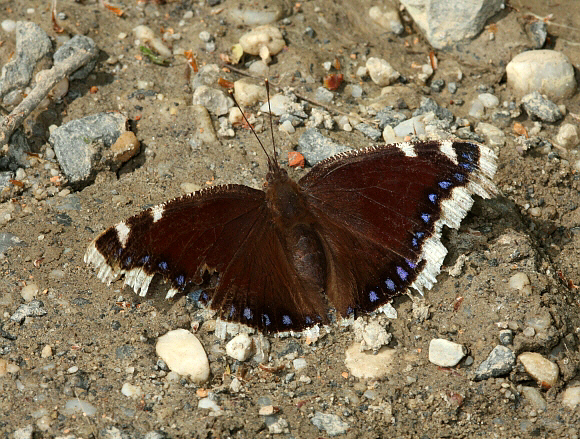 Camberwell Beauty Nymphalis antiopa, Hungary – Peter Bruce-Jones
Camberwell Beauty Nymphalis antiopa, Hungary – Peter Bruce-Jones
Introduction
The most recent revision by Walberg includes the 6 Aglais species ( Small Tortoiseshells ), plus the Peacock Inachis io, the Blue Admiral Kaniska canace, the Camberwell Beauty N. antiopa and the 5 Polygonia species within the genus Nymphalis which consequently now comprises of 29 species. The genus is very widespread with representatives across the entire Holarctic region. Only one species canace reaches into the Oriental region.
The genus can be recognised by their angular wing-shape and dark undersides which are marked with numerous fine blackish striations. Several of the species carry a white or silvery mark on the underside hindwing, which often appears in the shape of a symbol or letter, hence the Latin species names interrogationalis ( question mark ), comma, g-argenteum, c-album, c-aureum and l-album. The uppersides of the true Nymphalis species ( sensu stricta ) are a rich orange-brown colour, marked with a distinctive pattern of black spots and blotches.
Nymphalis antiopa is distributed across most of Europe but only occurs in Britain as a very scarce migrant. Beyond Europe it is found across temperate Asia, and over most of North America where it is known as the Mourning Cloak. The English name refers to the fact that the first recorded example was captured in Camberwell in London. It was originally known as the Grand Surprise, then went through a succession of other popular names including Willow Beauty and White Petticoat before the current name became widely adopted.
Habitats
Nymphalis antiopa breeds primarily in deciduous woodlands but is migratory in behaviour so can be found in a wide variety of habitats ranging from coastal dunes to dry rocky gullies, alpine meadows and city gardens. It has been recorded at elevations as high as 2300m but is most commonly seen between about 50-1500m.
Lifecycle
The eggs are laid is large batches forming a ring around a twig of the foodplant, usually quite high in the tree. The foodplants include various Salix and Populus species ( Salicaceae ). The larvae feed gregariously and live within a silken web during the early instars, but gradually split into smaller groups as they mature, and live solitarily in the final instar. The chrysalis is formed on the twigs of bushes or on tree trunks.
Adult behaviour
The adults emerge in late summer and spend 2 or 3 weeks feeding at sap runs or fermenting fruit to build up protein reserves prior to hibernating overwinter in hollow trees or log piles. Summer and autumn specimens are a beautiful deep maroon colour, with rich creamy yellow wing margins, but this quickly fades. Post-hibernation examples are duller and invariably have whitish or very pale margins. In spring the adults awaken and nectar at Salix catkins.
